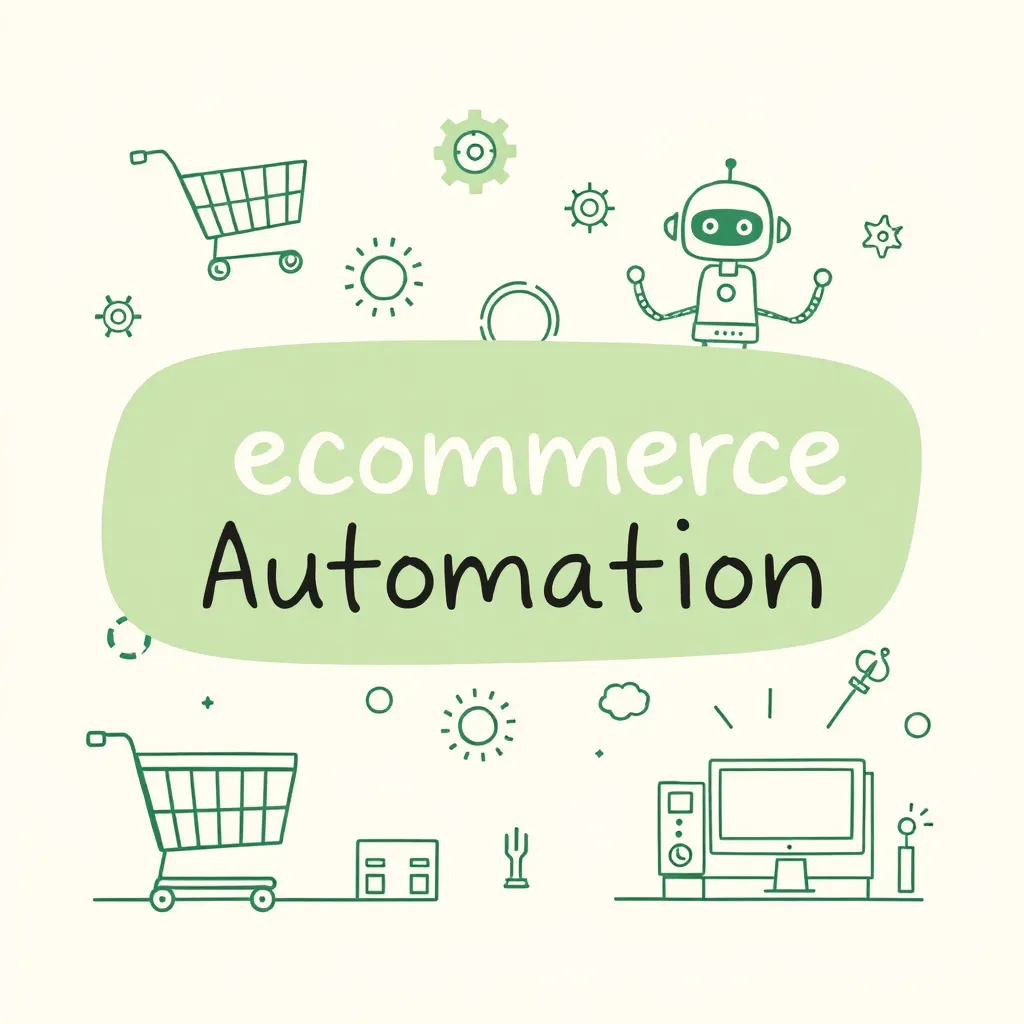Running an online business involves juggling multiple tasks—from managing inventory and processing orders to executing marketing campaigns and analyzing performance. eCommerce automation simplifies these repetitive processes by leveraging technology to handle them more efficiently.
Table of Contents
- Introduction to eCommerce Automation
- Tools for eCommerce Automation
- Strategies for Implementing Automation
- Marketing Insights for Automation
- Challenges in eCommerce Automation
- Choosing the Right Automation Platform
- Frequently Asked Questions (FAQs)
- Summary
Introduction to eCommerce Automation
At its core, eCommerce automation refers to using tools and software to execute manual tasks without direct human intervention. These solutions ensure that operations run smoothly and accurately, freeing up time for business owners to focus on strategic growth.
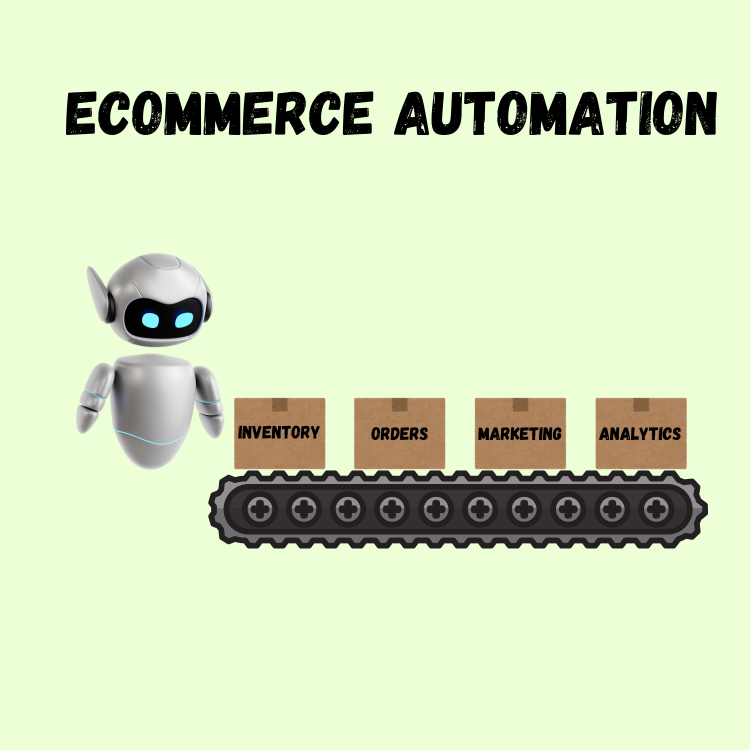
Why Automation Matters
- Efficiency: Automating routine tasks eliminates bottlenecks, ensuring quicker and more accurate operations.
- Error Reduction: Manual processes are prone to mistakes, such as mismanaging inventory or missing order updates. Automation minimizes these errors.
- Scalability: As your business grows, managing operations manually becomes overwhelming. Automation allows seamless scaling without the need for significant increases in resources.
- Cost Savings: By automating tasks like inventory updates or email campaigns, businesses reduce operational costs, such as labor expenses, while improving output.
Examples of Automation in eCommerce
Here are some everyday tasks eCommerce automation can optimize:
- Inventory Management: Real-time stock updates across multiple sales channels prevent overselling and stockouts.
- Order Processing: Automated systems centralize order collection, enabling faster fulfillment and better customer experiences.
- Marketing Campaigns: Tools like email automation and retargeting ads help businesses engage customers effectively without manual follow-ups.
- Reporting and Analytics: Automated reports provide insights into sales performance, customer behavior, and inventory trends, all without manual data crunching. Explore sales reports and templates.
A Real-Life Scenario
Imagine running an eCommerce business with multiple sales channels like Shopee, Lazada, and Amazon. Without automation, you’d have to update inventory manually for each platform, risking overselling or understocking. An automated system like OneCart can synchronize stock levels in real time across all platforms, saving hours of manual effort and ensuring accuracy.
In today’s competitive landscape, eCommerce automation is no longer optional—it’s a necessity. Businesses that embrace automation can stay agile, reduce costs, and provide better experiences for their customers. In the next sections, we’ll explore the tools, strategies, and insights that make automation a game-changer for online businesses.
The right tools are the foundation of successful eCommerce automation. They streamline operations, reduce manual effort, and enhance productivity by handling repetitive tasks efficiently. Here are key categories of eCommerce automation tools and how they transform various aspects of your business:
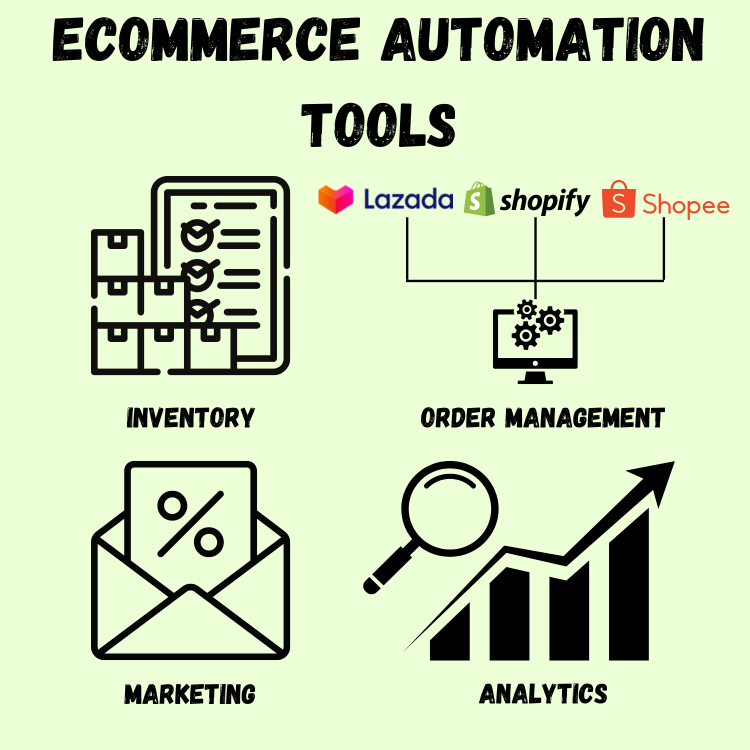
Managing inventory across multiple channels manually is prone to errors and inefficiencies. Automation tools like OneCart provide real-time inventory tracking and synchronization across platforms such as Shopee, Lazada, and Amazon.
-
Key Features:
- Real-time stock updates to avoid overselling and stockouts.
- Alerts for low stock levels to ensure timely replenishment.
- Centralized inventory management for multiple sales channels.
Example: Imagine a peak shopping season like Black Friday, where sales skyrocket. With inventory syncing in real time, tools like OneCart ensure you never sell more than what’s available, maintaining customer satisfaction and preventing costly errors.
Order Management Systems (OMS)
Order management is critical for ensuring smooth fulfillment. Automation tools centralize order collection and processing, reducing delays and errors. Learn about the benefits of order management systems.
-
Key Features:
- Collect orders from multiple platforms into a single dashboard.
- Automate order processing, from verification to shipping.
- Manage returns efficiently.
Example: A centralized OMS allows you to process orders from Shopify, TikTok Shop, and WooCommerce simultaneously. Instead of toggling between platforms, you handle everything from one interface, saving time and improving accuracy.
Marketing automation enhances customer engagement by delivering personalized experiences at scale. These tools automate tasks like email marketing, retargeting campaigns, and personalized recommendations.
-
Key Features:
- Automated email campaigns (welcome series, abandoned cart recovery, etc.).
- Personalized product recommendations based on customer behavior.
- Social media scheduling and ad campaign management.
Example: An abandoned cart recovery email sequence can be set up to automatically remind customers to complete their purchases, offering incentives like discounts to encourage conversion.
Understanding your performance metrics is vital for informed decision-making. Automation tools simplify reporting, offering real-time insights into sales, inventory, and customer behavior.
-
Key Features:
- Automated sales and inventory reports.
- Performance tracking by product, region, or channel.
- Predictive analytics for demand forecasting.
Example: OneCart’s analytics features provide a detailed breakdown of sales trends, helping you identify best-sellers and slow-moving products to optimize your inventory.
Customer Support Automation
Chatbots and automated help desks handle common queries, reducing the workload on customer service teams and ensuring faster response times.
-
Key Features:
- AI-powered chatbots to answer FAQs.
- Automated ticket routing for complex issues.
- Proactive notifications for order updates or delays.
Example: A chatbot integrated into your website can instantly answer questions about delivery times, reducing cart abandonment due to hesitation.
The real power of automation lies in integrating these tools into a seamless workflow. Platforms like OneCart act as a central hub, connecting inventory management, order processing, and analytics across all your sales channels. This ensures consistent operations and reduces the risk of errors.
Strategies for Implementing Automation
Implementing eCommerce automation requires a thoughtful approach to ensure maximum efficiency and scalability. Rushing into automation without proper planning can lead to inefficiencies and missed opportunities. Here’s a step-by-step guide to successfully automate your eCommerce operations:
1. Start with High-Impact, Repetitive Tasks
Identify the tasks in your business that consume the most time and are prone to human error. These are the best candidates for automation.
-
Examples:
- Automating inventory updates across multiple platforms.
- Sending order confirmation emails to customers.
- Generating sales reports weekly or monthly.
Why It Works: Automating repetitive tasks frees up your time and ensures consistent accuracy, allowing you to focus on strategic growth.
2. Prioritize Key Areas of Your Business
Not all parts of your business may need automation immediately. Focus on high-priority areas where automation can make the most impact.
-
Key Areas to Target:
- Inventory Management: Automate stock synchronization and low-stock alerts.
- Order Fulfillment: Streamline order processing to speed up delivery times.
- Marketing: Implement tools for email campaigns and personalized product recommendations.
Pro Tip: Use tools like OneCart to centralize and automate inventory, orders, and sales across all platforms, reducing manual coordination.
Use Case:
Track reviews on Trustpilot to monitor brand perception and identify recurring customer pain points.
3. Integrate Your Systems
The true power of automation lies in integrating your tools and systems. Ensure your automation solutions can work together seamlessly to create a unified workflow.
-
Example Integration:
- Connect your eCommerce platform (e.g., Shopify or WooCommerce) with an inventory management tool like OneCart.
- Sync with a marketing tool to automate personalized email campaigns triggered by customer actions (e.g., abandoned carts or repeat purchases).
Why It Matters: Integrated systems eliminate data silos and ensure consistent operations across all channels.
4. Monitor and Optimize Automation
Automation isn’t a “set it and forget it” solution. Regularly monitor your automated processes to ensure they’re working effectively and adjust as needed.
-
What to Monitor:
- Inventory levels to avoid stockouts or overselling.
- Customer engagement metrics for email campaigns.
- Order fulfillment times and error rates.
Pro Tip: Use OneCart’s analytics to track the performance of your inventory and sales, identifying areas for further optimization.
5. Scale Gradually
Start small and expand your automation efforts as your business grows. Focus on automating one area at a time to avoid overwhelming your team and systems.
-
Scaling Tips:
- Begin with inventory management, then move to order processing and marketing.
- As you grow, automate advanced processes like demand forecasting and dynamic pricing.
Why It Works: Gradual implementation reduces the risk of errors and helps your team adapt to new tools and workflows effectively.
Benefits:
- Track customer satisfaction across sales and support channels.
- Ensure consistent experiences for customers interacting on different platforms.
- Reduce response times and improve satisfaction scores.
Use Case:
Leverage OneCart to identify customer satisfaction trends tied to order fulfillment accuracy and shipping times.
6. Balance Automation with Human Oversight
While automation can handle repetitive tasks, some aspects of your business—like customer service and creative strategy—still benefit from human oversight.
-
Examples:
- Use chatbots for basic queries but have human agents available for complex issues.
- Automate sales reporting but involve team members in analyzing the insights and making strategic decisions.
Why It Matters: Automation is a tool to enhance your operations, not replace human expertise.
Marketing Insights for Automation
Marketing automation goes beyond convenience—it’s a powerful strategy to increase conversions, boost customer engagement, and grow your business. By leveraging automation tools and data-driven insights, you can create personalized marketing campaigns, streamline repetitive tasks, and optimize your outreach for maximum impact.
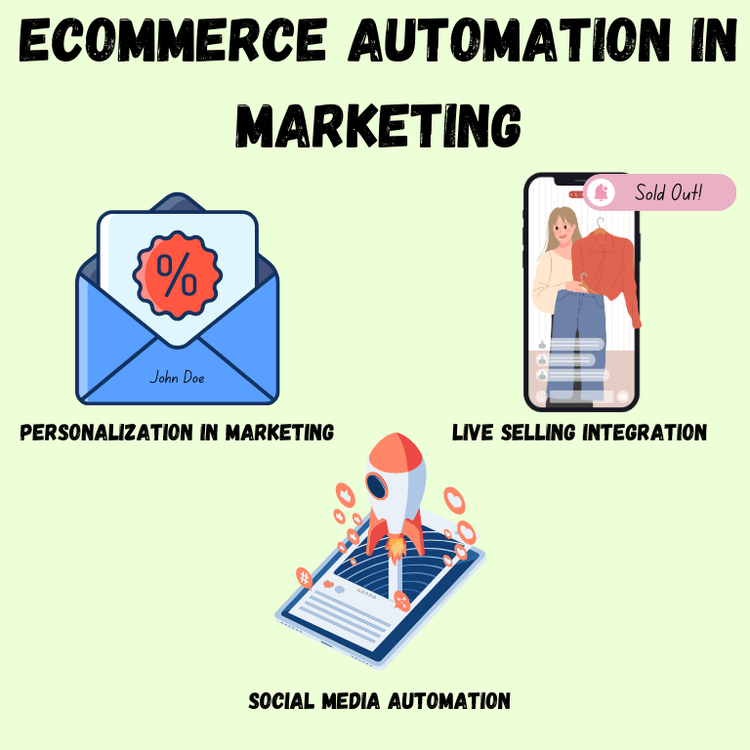
1. Personalization in Marketing
Automation allows you to deliver personalized experiences at scale, making every customer feel valued and understood. Personalized marketing improves engagement and drives higher conversion rates. Learn how to optimize your eCommerce sales funnel.
Pro Tip: Use email automation tools to create segmented campaigns targeting different customer groups, such as first-time buyers, repeat customers, or lapsed users.
2. Live Selling Integration
Live selling platforms like TikTok Shop and Shopee Live combine real-time customer interaction with the convenience of eCommerce. Automation tools can enhance the effectiveness of live selling by managing backend operations seamlessly.
Example: OneCart integrates with live selling platforms to ensure inventory and orders are updated in real time, providing a smooth customer experience.
Social media is a key channel for eCommerce marketing, but managing multiple platforms manually is time-consuming. Automation simplifies the process, helping you maintain a consistent presence and track performance.
Pro Tip: Incorporate shoppable posts and stories to turn social media engagement into direct sales opportunities.
4. Customer Retargeting
Retargeting is an effective way to re-engage customers who have shown interest in your products but haven’t completed a purchase. Automation makes it easy to create retargeting campaigns that are timely and personalized.
Why It Works: Retargeting leverages behavioral data to remind customers of their interest, increasing the likelihood of conversion.
Challenges in eCommerce Automation
While eCommerce automation offers significant advantages, implementing and managing it effectively can come with its own set of challenges. Understanding these pitfalls and how to overcome them is essential to ensure a smooth transition and maximize the benefits of automation.
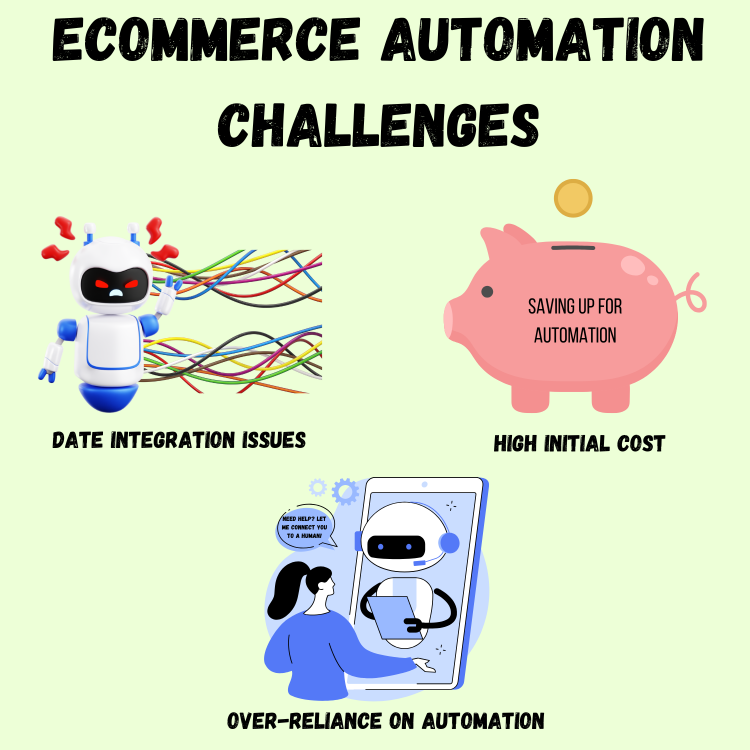
1. Data Integration Issues
Automation relies on accurate, real-time data to function effectively. However, integrating various systems, such as inventory management, sales channels, and marketing tools, can be complex. Find out more about ERP integration.
-
Challenges:
- Incompatible platforms causing data silos.
- Delays in syncing data, leading to inaccurate stock levels or order discrepancies.
-
Solutions:
- Use platforms like OneCart that offer robust integrations with multiple eCommerce tools and marketplaces.
- Prioritize tools that support APIs or pre-built integrations to simplify connectivity.
- Conduct regular audits to ensure data flows correctly between systems.
2. High Initial Cost
Setting up automation tools can require a significant upfront investment, especially for small or medium-sized businesses.
-
Challenges:
- Subscription fees for software tools.
- Costs associated with onboarding, training, and system customization.
-
Solutions:
- Start with affordable, scalable tools like OneCart, which offers flexible pricing for businesses of all sizes.
- Focus on automating high-impact areas first, such as inventory synchronization or order management, to see quick returns on investment.
- Monitor ROI from automation to justify further investments over time.
3. Over-Reliance on Automation
While automation handles repetitive tasks efficiently, over-reliance can lead to a lack of human oversight, which is crucial for resolving complex issues or maintaining a personal touch in customer interactions.
-
Challenges:
- Automated systems might fail to address unique customer concerns.
- Lack of manual intervention can result in unnoticed errors or missed opportunities.
-
Solutions:
- Combine automation with human oversight, especially for customer service and strategy-related tasks.
- Use automation for efficiency but maintain flexibility for human intervention in complex scenarios.
- Train staff to monitor and optimize automated workflows continuously.
Selecting the right automation platform is crucial to streamline your eCommerce operations effectively. The ideal solution should address your business needs, integrate seamlessly with existing systems, and scale as you grow. Here’s a guide to help you choose the perfect automation platform for your business:
1. Assess Your Business Needs
Start by identifying the areas where automation can have the most significant impact on your business.
2. Ensure Seamless Integration
An effective automation platform should integrate with your existing systems and sales channels to avoid data silos.
-
What to Look For:
- Compatibility with major eCommerce platforms (e.g., Shopify, WooCommerce, Shopee, Lazada).
- APIs or pre-built integrations for easy connectivity with CRMs, ERP systems, and marketing tools.
- Centralized management of multichannel operations.
Pro Tip: OneCart’s seamless integration across platforms ensures real-time synchronization of inventory, orders, and analytics.
3. Prioritize User-Friendliness
Complex automation systems can be a barrier for businesses without technical expertise. Choose a platform with an intuitive interface and minimal learning curve.
-
Features to Consider:
- Simple setup and onboarding processes.
- Clear dashboards with actionable insights.
- Responsive customer support and detailed documentation.
Why It Matters: User-friendly platforms like OneCart allow your team to adopt automation quickly, ensuring faster results and smoother transitions.
4. Evaluate Scalability
Your automation platform should grow with your business. A scalable solution ensures that as your operations expand, your automation tools remain effective.
-
Scalability Features:
- Support for additional sales channels and increased order volumes.
- Advanced features like demand forecasting and dynamic pricing for larger operations.
- Flexible pricing plans to accommodate different business sizes.
Example: OneCart offers scalable solutions, allowing businesses to start small and expand their automation efforts as needed.
Frequently Asked Questions (FAQs)
1. What is eCommerce automation, and why is it important?
eCommerce automation uses technology to streamline repetitive tasks like inventory updates, order processing, and marketing campaigns. It’s important because it improves efficiency, reduces errors, and allows businesses to scale without overloading their resources.
2. Which tasks should I automate first?
Start with high-impact, repetitive tasks that consume the most time and are prone to errors, such as:
- Inventory synchronization across multiple sales channels.
- Order processing and fulfillment.
- Abandoned cart recovery email campaigns.
- Generating sales reports and performance insights.
Choose platforms that support APIs or pre-built integrations with your existing tools. Solutions like OneCart are designed to work seamlessly with major eCommerce platforms like Shopee, Lazada, Shopify, and WooCommerce.
4. What are the risks of over-reliance on automation?
While automation enhances efficiency, over-reliance can lead to:
- Lack of human oversight for unique or complex issues.
- Missed opportunities for personalized customer interactions.
- Dependence on systems without backup plans in case of technical glitches.
5. What are the costs of implementing automation?
Costs vary based on the tools you choose and your business size. Common expenses include:
- Subscription fees for automation platforms.
- Initial setup and training costs.
- Ongoing maintenance for advanced integrations.
Pro Tip: Start small by automating high-priority areas, then expand as your budget and operations grow.
6. Can automation handle multichannel eCommerce operations?
Yes. Platforms like OneCart are specifically designed for multichannel sellers, offering:
- Real-time inventory synchronization across platforms like Shopify, Lazada, and Amazon.
- Centralized order management for quicker processing.
- Analytics to track performance across all channels.
Summary
eCommerce automation streamlines repetitive tasks like inventory management and order processing, enabling businesses to improve efficiency, reduce errors, and scale seamlessly. By integrating tools like OneCart, you can synchronize inventory across channels and process orders faster—all while gaining valuable insights from automated analytics. Starting small with high-impact tasks and gradually scaling ensures a smooth transition, balancing automation with human oversight for optimal results. Embracing automation not only enhances customer satisfaction but also positions your business for sustainable growth and competitive advantage.
Ready to take your eCommerce business to the next level? Start your automation journey with OneCart for inventory management, order processing, and analytics.
